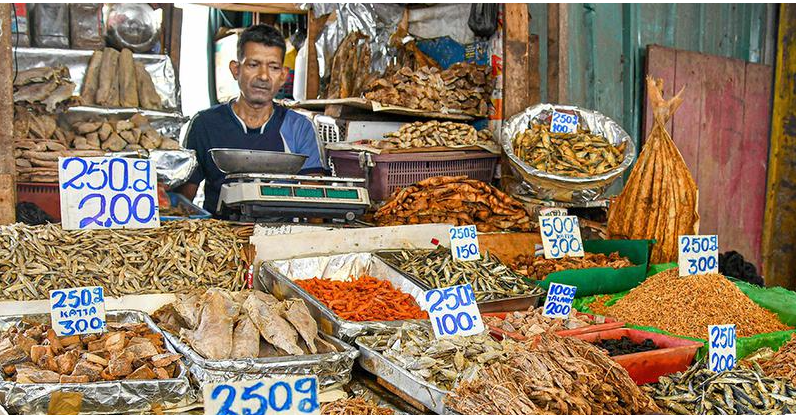1. Introduction
Highest Deflation Sri Lanka has recorded a historic economic milestone as prices in the country fell by 2.1%, marking the highest deflation rate since 1961. This development, while indicative of easing inflationary pressures, brings its own set of challenges for a nation still recovering from a severe economic crisis.
This article examines the causes behind this deflation, its implications for the Sri Lankan economy, and the road ahead for policymakers and citizens.
2. What is Deflation?
Deflation refers to a sustained decline in the general price level of goods and services in an economy. While it may seem like good news for consumers, deflation can be a sign of weak demand and economic stagnation, leading to adverse effects like reduced business profits, job cuts, and lower investments. 
3. Key Drivers Behind Sri Lanka’s Deflation
3.1. High Inflation Followed by Economic Correction
Sri Lanka recently endured one of its worst inflationary crises, with inflation peaking at 70% in September 2022. The current deflationary trend reflects a significant correction following stringent economic reforms and improved monetary policies.
3.2. Currency Stabilization
The Sri Lankan rupee has stabilized after a period of extreme volatility. This stability has reduced import costs, a key factor in lowering overall prices.
3.3. Decline in Global Commodity Prices
A decrease in global prices of essential commodities, such as fuel and food, has also contributed to the deflationary trend.
3.4. Improved Supply Chain Management
Post-crisis efforts to streamline supply chains and ensure adequate availability of goods have helped reduce price pressures.
4. Sectoral Analysis of Price Decline
4.1. Food and Beverages
- Significant Drop: Prices of staple items like rice, vegetables, and cooking oil have witnessed substantial reductions.
- Reasons: Improved agricultural output and stable imports have contributed to price drops.
4.2. Energy
- Lower fuel prices, both domestically and globally, have had a cascading effect on transportation and production costs.
4.3. Housing and Utilities
- Reduced energy costs have resulted in lower electricity and gas bills for households.
5. Implications of Deflation
5.1. Positive Impacts
- Relief for Consumers: Lower prices have eased the financial burden on citizens still grappling with the aftershocks of last year’s economic crisis.
- Improved Purchasing Power: Households can now afford more goods and services with the same income.
5.2. Negative Impacts
- Reduced Business Revenues: Lower prices can result in shrinking profit margins for businesses, discouraging investment and expansion.
- Debt Burden: Deflation increases the real value of debt, making repayment more challenging for individuals and businesses.
- Economic Stagnation: A prolonged deflationary period may lead to reduced economic activity and slower growth.
6. Comparison with Historical Trends
6.1. The 1961 Deflation
- The current 2.1% deflation rate is the highest since 1961, Highest Deflation a period characterized by global economic changes and domestic reforms in Sri Lanka.
6.2. Recent Inflationary Period
- Contrasted with last year’s hyperinflation, Highest Deflation the current deflation represents a dramatic turnaround in the economic landscape.
7. Government’s Role in Managing Deflation
7.1. Monetary Policies
The Central Bank of Sri Lanka (CBSL) has implemented measures to stabilize the currency and control inflation, but it must now carefully manage liquidity to avoid prolonged deflation.
7.2. Fiscal Policies
- Increased government spending on infrastructure and public services could help stimulate demand and counter deflationary pressures.
- Targeted subsidies for key industries may also encourage production and investment.
7.3. Structural Reforms
Continued focus on improving governance, reducing corruption, Highest Deflation and ensuring efficient allocation of resources is critical to long-term economic stability.
8. International Context
8.1. Lessons from Other Countries
Countries like Japan have grappled with prolonged deflation, offering valuable lessons on the importance of balancing monetary and fiscal policies.
8.2. Role of Global Economic Trends
The current global economic environment, marked by fluctuating commodity prices and geopolitical tensions, will play a crucial role in shaping Sri Lanka’s economic trajectory.
9. Perspectives from Stakeholders
9.1. Citizens
- Many Sri Lankans have welcomed the drop in prices, Highest Deflation but concerns remain about job security and economic growth.
- “Lower prices are a relief, but we need stable jobs and better opportunities,” Highest Deflation said a Colombo-based teacher.
9.2. Business Owners
- Small businesses are feeling the pinch due to reduced revenues.
- “We’re struggling to make profits despite higher sales volumes,” commented a local shopkeeper.
9.3. Economists
- Experts warn that while deflation provides short-term relief, Highest Deflation it could signal deeper structural problems in the economy.
10. Future Outlook
10.1. Avoiding Prolonged Deflation
Policymakers must act swiftly to stimulate demand and prevent the economy from slipping into a deflationary spiral.
10.2. Balancing Inflation and Growth
A moderate inflation rate, typically around 2-3%, is ideal for fostering economic growth while ensuring price stability.
10.3. Building Resilience
Sri Lanka must focus on diversifying its economy, boosting exports, Highest Deflation and reducing reliance on imports to build long-term resilience.
11. Conclusion
Sri Lanka’s record deflation of 2.1% reflects significant progress in overcoming last year’s economic turmoil. However, the challenges associated with deflation require careful management to ensure sustained economic recovery.
As the nation navigates this delicate phase, the focus must remain on fostering growth, creating jobs, and building a resilient economy that can withstand future shocks. The coming months will be crucial in determining whether this deflationary trend signals a turning point or a new set of challenges for Sri Lanka. ALSO READ:-India’s GDP Growth Slows to 5.4% in Q2: Challenges and Road Ahead 2024